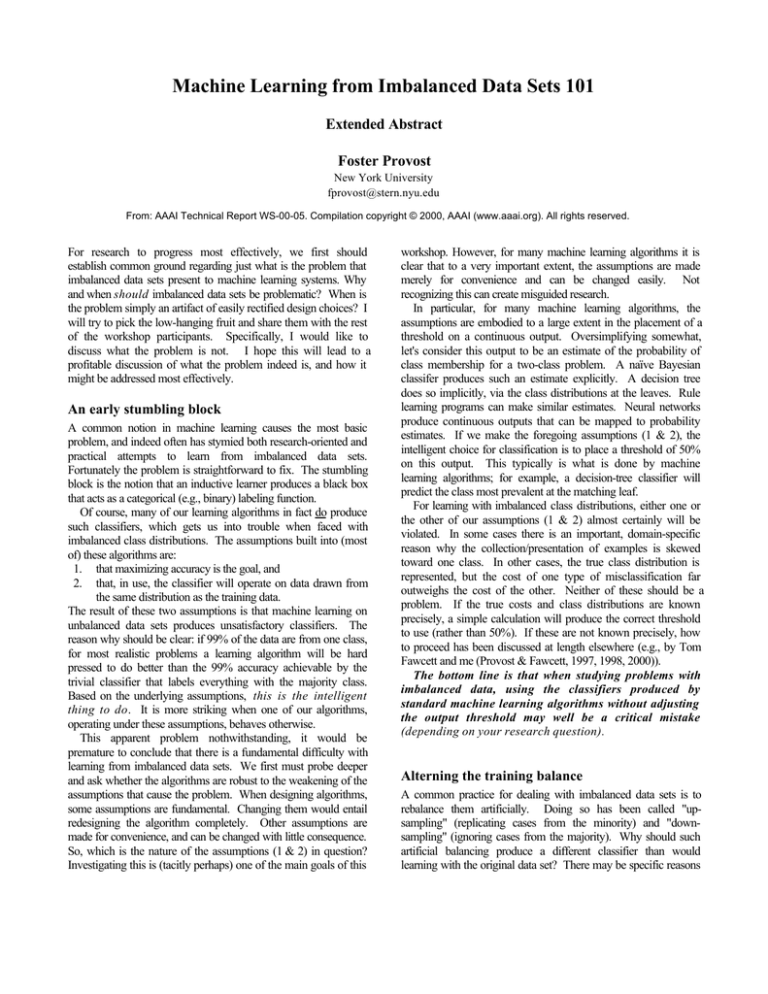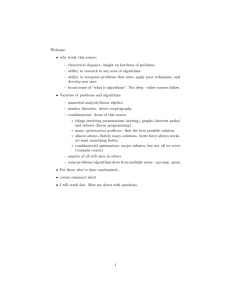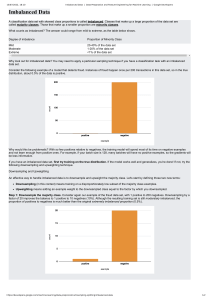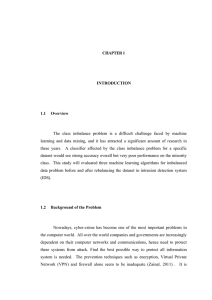
Machine Learning from Imbalanced Data Sets 101
Extended Abstract
Foster Provost
New York University
fprovost@stern.nyu.edu
From: AAAI Technical Report WS-00-05. Compilation copyright © 2000, AAAI (www.aaai.org). All rights reserved.
For research to progress most effectively, we first should
establish common ground regarding just what is the problem that
imbalanced data sets present to machine learning systems. Why
and when should imbalanced data sets be problematic? When is
the problem simply an artifact of easily rectified design choices? I
will try to pick the low-hanging fruit and share them with the rest
of the workshop participants. Specifically, I would like to
discuss what the problem is not. I hope this will lead to a
profitable discussion of what the problem indeed is, and how it
might be addressed most effectively.
An early stumbling block
A common notion in machine learning causes the most basic
problem, and indeed often has stymied both research-oriented and
practical attempts to learn from imbalanced data sets.
Fortunately the problem is straightforward to fix. The stumbling
block is the notion that an inductive learner produces a black box
that acts as a categorical (e.g., binary) labeling function.
Of course, many of our learning algorithms in fact do produce
such classifiers, which gets us into trouble when faced with
imbalanced class distributions. The assumptions built into (most
of) these algorithms are:
1. that maximizing accuracy is the goal, and
2. that, in use, the classifier will operate on data drawn from
the same distribution as the training data.
The result of these two assumptions is that machine learning on
unbalanced data sets produces unsatisfactory classifiers. The
reason why should be clear: if 99% of the data are from one class,
for most realistic problems a learning algorithm will be hard
pressed to do better than the 99% accuracy achievable by the
trivial classifier that labels everything with the majority class.
Based on the underlying assumptions, this is the intelligent
thing to do. It is more striking when one of our algorithms,
operating under these assumptions, behaves otherwise.
This apparent problem nothwithstanding, it would be
premature to conclude that there is a fundamental difficulty with
learning from imbalanced data sets. We first must probe deeper
and ask whether the algorithms are robust to the weakening of the
assumptions that cause the problem. When designing algorithms,
some assumptions are fundamental. Changing them would entail
redesigning the algorithm completely. Other assumptions are
made for convenience, and can be changed with little consequence.
So, which is the nature of the assumptions (1 & 2) in question?
Investigating this is (tacitly perhaps) one of the main goals of this
workshop. However, for many machine learning algorithms it is
clear that to a very important extent, the assumptions are made
merely for convenience and can be changed easily. Not
recognizing this can create misguided research.
In particular, for many machine learning algorithms, the
assumptions are embodied to a large extent in the placement of a
threshold on a continuous output. Oversimplifying somewhat,
let's consider this output to be an estimate of the probability of
class membership for a two-class problem. A naïve Bayesian
classifer produces such an estimate explicitly. A decision tree
does so implicitly, via the class distributions at the leaves. Rule
learning programs can make similar estimates. Neural networks
produce continuous outputs that can be mapped to probability
estimates. If we make the foregoing assumptions (1 & 2), the
intelligent choice for classification is to place a threshold of 50%
on this output. This typically is what is done by machine
learning algorithms; for example, a decision-tree classifier will
predict the class most prevalent at the matching leaf.
For learning with imbalanced class distributions, either one or
the other of our assumptions (1 & 2) almost certainly will be
violated. In some cases there is an important, domain-specific
reason why the collection/presentation of examples is skewed
toward one class. In other cases, the true class distribution is
represented, but the cost of one type of misclassification far
outweighs the cost of the other. Neither of these should be a
problem. If the true costs and class distributions are known
precisely, a simple calculation will produce the correct threshold
to use (rather than 50%). If these are not known precisely, how
to proceed has been discussed at length elsewhere (e.g., by Tom
Fawcett and me (Provost & Fawcett, 1997, 1998, 2000)).
The bottom line is that when studying problems with
imbalanced data, using the classifiers produced by
standard machine learning algorithms without adjusting
the output threshold may well be a critical mistake
(depending on your research question).
Alterning the training balance
A common practice for dealing with imbalanced data sets is to
rebalance them artificially. Doing so has been called "upsampling" (replicating cases from the minority) and "downsampling" (ignoring cases from the majority). Why should such
artificial balancing produce a different classifier than would
learning with the original data set? There may be specific reasons
for specific learning algorithms, but it is important that the
fundamental reasons for different behavior with different
stratifications not be confounded with the issue of proper
setting of the output threshold (discussed in the previous
section). I have seen plenty of studies where the "problem" of
imbalanced data sets was demonstrated, and then "solved" with
up-sampling or down-sampling. Other studies demonstrate that
up-sampling or down-sampling does not solve the problem. In
most of these studies, it never even was asked whether simply
setting the output threshold correctly would be sufficient;
without doing so the research may be misleading. (An alternative
research methodology is not to consider any particular threshold,
but to compare the quality of the models' probability
distributions more generally, e.g., across all possible thresholds).
I hasten to add here that I am by no means claiming that there
is no benefit to artificially balancing for improving induction. To
my knowledge the question is still open as to whether simply
changing the distribution skew (without actually looking at
different data) can improve predictive performance
systematically.
On the other hand, there is some evidence that rebalancing the
classes artificially in fact does not have a great effect on the
predictive performance of learned classifiers. For example, the
naïve Bayesian classifier is quite insensitive to stratification.
Recent results on decision-tree splitting criteria show that they
too are not as sensitive to class skew as conventional wisdom
might dictate (Drummond & Holte, 2000).
Designing better sampling strategies
A hope of mine is that from this workshop, and the subsequent
research that it stimulates, I will understand more clearly the
problem of imbalanced data sets and what to do in their presence.
Is the problem simply that there are not enough instances of one
class for satisfactory learning? (For extreme imbalances and lessthan-massive data sets this certainly is part of the explanation.)
Or are there important pathologies of our learning algorithms that
become evident when the distributions are highly imbalanced. I
will leave the latter to other work, but let me address the former in
more detail.
Imbalanced data sets are a problem particularly when there
simply are too few data of a certain class, and you end up with
problems such as a complete lack of representation of certain
important aspects of the minority class. In such cases, it may be
useful to look to methods for "profiling" the majority class
without reference to instances of the other. I will not address this
situation further here either.
There still remains a problem that I believe deserves further
investigation, because it has implications for machine learning
research more broadly. What is the appropriate sampling
strategy for a given data set? Is there any reason to believe
that the different classes that make up a single learning task will
be equally difficult (in terms of the number of instances needed)
to learn?
Experience tells us that it is almost always impossible to
predict how easy it will be to learn a real-world concept with a
complex machine-learning algorithm. However, it may be possible
to adjust a sampling strategy dynamically by observing some
indicator of the ease of learning the different classes. The most
extreme version of this strategy is completely "active" learning:
model-based instance selection in an incremental setting, which
harkens back to Winston's notion of the "near miss" in the 1970's.
I have discussed elsewhere the notion of explicitly considering the
search of the example space when designing a learning program
(Provost & Buchanan, 1995). What is relevant here is that one
can envision a wide variety of policies for doing so, at various
points along the spectrum from just taking the distribution as
given, all the way to the active selection of each individual
instance. If we can understand how machine learning algorithms
perform with imbalanced data sets, we can understand how best
to operate at certain points along this spectrum. (Note that there
is no reason to believe that a 50/50 class distribution would
necessarily be best even if the target population is distributed
50/50.)
For example, research may show (I know of no such results
yet) that all else being equal--in particular the number of training
data--it is better to skew the training distribution toward the class
with the larger proportion of small disjuncts. This makes sense,
since much research has shown that small disjuncts are more error
prone (Weiss, 2000). If this turns out to be so, it may be possible
to design a progressive sampling strategy (Provost, Jensen, and
Oates, 1999) that decides how next to sample by analyzing the
prevalence of small disjuncts in the different classes.
Is understanding these basics really worthwhile?
I have tried to provide rationale here for understanding the basics,
including: the need for control conditions for empirical analyses,
the desire to identify pathological behaviors of our existing
algorithms, the possibility of designing better sampling strategies,
as well as the production of new and improved learning
algorithms.
A potential criticism of the sampling rationale has some
validity and so is worth discussing at this workshop. One might
say that typically, in a machine learning setting, you have the
data you have. Adjusting the class balance by necessity is
limited either to replicating the minority class or to throwing
away some of the majority class. The former does not add
information and the latter actually removes information.
Considering this fact, isn't the best research strategy to
concentrate on how machine learning algorithms can deal most
effectively with whatever data they are given?
There certainly are situations where there is a static, small or
moderate-size data set to be used and no opportunity to add to it.
However, in my experience, typically either (i) you have far more
data than your algorithms can deal with, and you have to select a
sample, or (ii) you have no data at all and you have to go through
an involved process to create them. In the first case, a simple but
vexing practical question is how many data to sample and in what
proportion. In the second case, creating data is costly and once
again there is the question of how many data to create and in what
proportion.
Conclusion
Machine learning from imbalanced data sets is an important
problem, both practically and for research. I am confident that
developing a clear understanding of this particular problem will
have broader-ranging implications for machine learning and AI
research. Above I discussed briefly particular interactions with
the design of sampling strategies and with the problem of small
disjuncts, and I believe that deep understanding of active learning
can not be achieved without concomitant understanding of the
(simpler) problem of learning with imbalanced data sets.
However, I believe also that success at these grander goals will be
precarious if we do not first attend to the basics. I thank the
workshop organizers for helping to ensure that we do.
Acknowledgements
Thanks to the many with whom I've discussed learning from
imbalanced data sets, especially Tom Fawcett.
References
Drummond, C. and R. Holte (2000). "Exploiting the Cost
(In)sensitivity of Decision Tree Splitting Criteria." Proceedings
of the Seventeenth International Conference on Machine
Learning (To Appear)
Provost, F. and B. Buchanan, (1995). "Inductive Policy: The
Pragmatics of Bias Selection." Machine Learning 20, pp. 3561.
Provost, F. and T. Fawcett (2000). "Robust Classification for
Imprecise Environments." To appear in Machine Learning.
Provost, F. and T. Fawcett (1998). "Robust Classification
Systems for Imprecise Environments." In Proceedings of the
Fifteenth National Conference on Artificial Intelligence.
Provost, F. and T. Fawcett (1997). "Analysis and Visualization of
Classifier Performance: Comparison under Imprecise Class and
Cost Distributions." In Proceedings of the Third
International Conference on Knowledge Discovery and
Data Mining.
Provost, F., D. Jensen and T. Oates (1999). "Efficient Progressive
Sampling." In Proceedings of the Fifth International
Conference on Knowledge Discovery and Data Mining.
G. Weiss (2000). Small Disjuncts: A Research Summary.
http://www.cs.rutgers.edu/~gweiss/small_disjuncts.html







